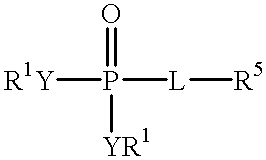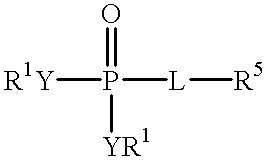Novel aryl fructose-1,6-Bisphosphatase inhibitors
a technology of aryl fructose and inhibitors, which is applied in the field of new aryl fructose-1,6-bisphosphatase inhibitors, can solve the problems of limiting the overall success of sulfonylurea therapy, limiting the overall success of niddm patients, and large segment of the niddm population that does not respond adequately to sulfonylurea therapy, etc., to enhance cell penetration, enhancing the stability of stability
- Summary
- Abstract
- Description
- Claims
- Application Information
AI Technical Summary
Benefits of technology
Problems solved by technology
Method used
Image
Examples
example 1
[0715] Preparation of 5-(3,5-Dinitrophenyl)-2-furanphosphonic Acid (Compound no. 1.01).
[0716] Step A.
[0717] A solution of furan (1 mmole) in 1 mL diethyl ether was treated with N,N,N'N'-tetramethylethylenediamine (TMEDA) (1 mmole) and nBuLi (1.1 mmole) at -78.degree. C. for 0.5 h. The resulting solution was cannulated into a solution of diethyl chlorophosphate (1.33 mmole) in 1 mL of diethyl ether at -60.degree. C. and the reaction mixture allowed to rise to rt and stirred for another 16 h. Extraction and distillation at 75.degree. C. / 0.2 mm produced diethyl 2-furanphosphonate as a clear oil.
[0718] Step B.
[0719] A solution of diethyl 2-furanphosphonate (1 mmol) in 2 mL THF was cooled to -78.degree. C. and added to a solution of lithium diisopropylamide (LDA) (1 mmol) in 5 mL THF at -78.degree. C. over 20 min. The resulting mixture was stirred -78.degree. C. for 20 min and added into a solution of tributyltin chloride (1 mmole) in 1 mL THF at -78.degree. C. over 20 min. The mixture w...
example 2
[0724] Preparation of 5-(4-Fluorophenyl)-2-furanphosphonic Acid (Compound no. 2.01).
[0725] Step A.
[0726] A solution of diethyl 2-furanphosphonate (prepared as described in Step A, Example 1) (1 mmol) in 2 mL THF was cooled to -78.degree. C. and added to a solution of lithium isopropylcyclohexylamide (LICA) (1 mmol) in 2 mL THF at -78.degree. C. over 20 min. The resulting mixture was stirred -78.degree. C. for 20 min and added into a solution of iodine (1 mmole) in 1 mL THF at -78.degree. C. over 20 min. The mixture was then stirred at -78.degree. C. for 20 min. Extraction and chromatography provided diethyl 5-iodo-2-furanphosphonate as a yellow oil.
[0727] Step B.
[0728] A mixture of diethyl 5-iodo-2-furanphosphonate (1 mmol), 4-fluorophenylboronic acid (2 mmol), diisopropylethylamine (DIEA) (4 mmol) and bis(acetonitrile)dichloropalladium(II) (0.05 mmol) in 6 mL DMF was heated at 75.degree. C. for 16 h. Extraction and chromatography provided diethyl 5-(4-fluorophenyl)-2-furanphosphona...
example 3
[0732] Preparation of 5-(4-Bromo-3-aminophenyl)-2-furanphosphonic Acid (Compound no. 3.01).
[0733] Step A.
[0734] Reaction of 3-aminophenylboronic acid hydrochloride with diethyl 5-iodo-2-furanphosphonate as described in Step B of Example 2 provided diethyl 5-(3-aminophenyl)-2-furanphosphonate as an oil.
[0735] Step B.
[0736] A mixture of diethyl 5-(3-aminophenyl)-2-furanphosphonate (1 mmol), NBS (0.9 mmol) and AIBN (0.1 mmol) in 30 mL of CCl.sub.4 was stirred at rt for 2 h. Extraction and chromatography provided diethyl 5-(4-bromo-3-aminophenyl)-2-filranphosphonate as an oil.
[0737] Step C.
[0738] Application of Step D, Example 1, to this material provided the title compound no. 3.01) as a white solid. HPLC R.sub.t=4.72 min; negative ion electrospray MS M-1 found: 316 / 318.
PUM
| Property | Measurement | Unit |
|---|---|---|
| Fraction | aaaaa | aaaaa |
| Fraction | aaaaa | aaaaa |
| Fraction | aaaaa | aaaaa |
Abstract
Description
Claims
Application Information
 Login to View More
Login to View More - R&D
- Intellectual Property
- Life Sciences
- Materials
- Tech Scout
- Unparalleled Data Quality
- Higher Quality Content
- 60% Fewer Hallucinations
Browse by: Latest US Patents, China's latest patents, Technical Efficacy Thesaurus, Application Domain, Technology Topic, Popular Technical Reports.
© 2025 PatSnap. All rights reserved.Legal|Privacy policy|Modern Slavery Act Transparency Statement|Sitemap|About US| Contact US: help@patsnap.com



